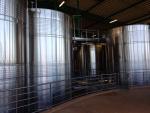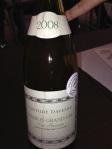Welcome to binNotes’ Terroir-ist Tuesday series on Burgundy.
Chablis, Part 3 of 3: La Chablisienne – Co-Op Confidential
by L.M. Archer, FWS



Part I: Fun Facts about Chablis
- Chablis is the second largest wine-growing region in Burgundy, behind the Mâconnais.
- Chablis average production: ~8,000-10,000 vines @hectare (1 hectare = 2.471 acres)
- Chablis total acreage: ~16, 675 acres
- Pruning method: Guyot.
- Soils: Primarily Kimmeridgian soil, with Portlandian predominant in lower growing regions.
Chablis’s Kimmeridgian soils elicit a specific flavor profile the French refer to as ”goût de pierre à fusil“, as in ‘taste of gunflint.’ Wine wags choose the term ‘minerality‘ to describe these wines of frankness, precision and tense character.
Part II: Co-0p Confidential
If you’re a wine grower in Chablis, chances are you may belong to La Chablisienne wine co-op. Chablis’ La Chablisienne wine co-op was founded in 1923. Today it boasts over 250 growers. Membership has its privileges, as well as its regulations.
What sort of regulations? Well, they include:
- Membership is voluntary.
- Members must stay a minimum of 5 years.
- Members must turn over 100% of production.
- Members must maintain quality.
- The co-op must receive all juice; however, the co-op may not pay producers of poor quality juice/must.*
In addition:
- Producers DO receive bottles back for personal use.
- The start price at time of receipt of juice/must may vary in two years after fermentation and bottling.
- The co-op pays overhead and administrative costs first, then the producers.
*Note: In the case of inferior quality production, the co-op will work with wine grower to improve quality, but may reject repeat offenders who do not improve within 2-3 yrs.
During binNotes visit, La Chablisienne advised that the 2013 harvest produced 30% lower yields than normal, due to rain in June, which effected flowering.



So what’s the drill for a typical La Chablisienne co-op wine grower/member?
Basically, each harvest goes something like this:
- Members (producers) grow the grapes.
- The co-op wine maker also visits vineyards to ensure ‘maturity’ control. (The co-op typically has over -2600 maturity controls.)
- Producers determine when to pick, with input from the co-op wine maker.
- Producers harvest and press the grapes.
- The co-op uses one of twenty (20) pump trucks comes to pick up must.
- The tank trucks deliver the must to La Chablisienne, where it’s graded: A,B,C – depending upon quality of taste.
- The must is tanked for débourbage (settling).
- The must is then fermented in traditional method, utilizing temperature controls.
- Malolactic fermentation typically does not occur, in order to maintain Chablis’ trademark crispness, unless acid levels merit it.
- Aging for Petit Chablis and Chablis: Typically 5 months on lees in tank.
- Aging for Premier and Grand Cru: Typically 18 months on lees in oak.
- The co-op waits until after harvest to bottle, in order to allow wines to mature on lees for freshness and balance.
Bottom line: Producers sign over their grapes, as well as the headaches and costs associated with fermenting, bottling, and selling the wine. But they never sign over their relationship with Mother Nature, nor their dedication to maintaining Chablis’ traditions and heritage.


Part III: Le Caveau
No visit to La Chablisienne would be complete without a tasting at Le Caveau, its tasting facility. Here’s a list of what binNotes and crew tasted, with a few cursory tasting notes scribbled in the margins:
1. 2011 Petit Chablis: Valley – 2011 was a particularly ‘fresh’ vintage. Indeed.
2. 2011 Old Vine Chablis: 30+ yrs.
3. 2011 Che de Lechet: Premier Cru – Citrus
4. 2011 Montmain Premier Cru – Mineral
5. 2011 V-??? (undecipherable Premier Cru…no tasting notes…oh, well…)
6. 2001 Mont-de-Milleu Granad Cru – Literally means ‘In the middle’ between Champagne and Burgundy. A little more open other Grand Crus, therefore more saline.
7. 2010 Les Prueses: Rounder, fuller, butter, brioche flavors.
8. 2010 Les Grenouilles : Tres elegant – complex, lingering. ***(binNotes’ fave.)
Want to learn more about La Chablisienne Co-op? Link to some cool La Chablisienne videos here.
Thanks to:
BIVB Chablis
La Chablisienne
☂☂☂
For more on Chablis by binNotes:
Chablis: Part 1 of 3
Chablis: Part 2 of 3
Copyrighted 2013. All Rights Reserved. All photos courtesy of the author.
Follow binNotes: Facebook Twitter Pinterest
Filed under: Chablis, Chardonnay, France, French Wine, French Wineries, Terroir, Wine Tasting Tagged: Burgundy wine, Chablis, french wine co-op, la chablisienne, wine

